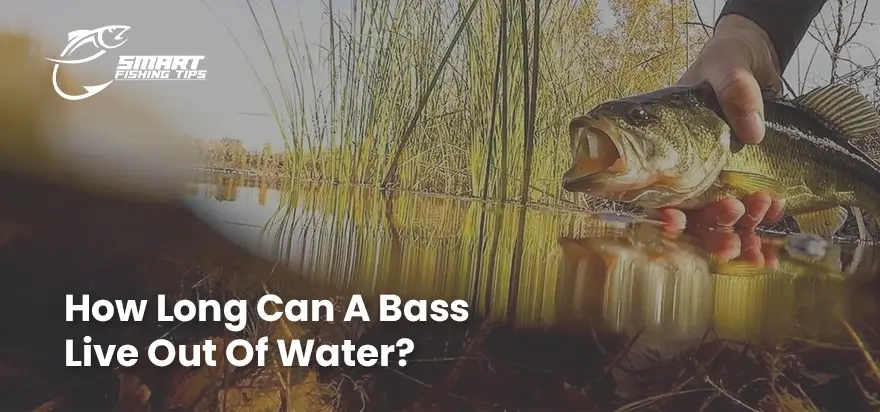“A fish out of water is the same as a human underwater, both will eventually die”. This phrase depicts the true physical and physiological stress a bass has to go through when held out of water because every minute out of water is touring for bass. That’s why being a responsible and passionate angler, you must learn gentle ways to handle your bass.
In this article, after going through the difference between underwater and above water environments for bass, we will be talking about different research studies conducted to answer how long can a bass live out of water without dying and then in the last section, we will enlighten you with various gentle ways of handling your bass after catching so that not only it is recreational for you but also easy on your prized bass.
How do Bass Survive Underwater?
Like any other fish, bass also requires oxygen to survive. Just like humans get oxygen from the air, the bass gets oxygen from water. Bass gulp water through their mouth and expel it from their gills. Their gills have feathery filaments enriched with blood vessels. When water leaves these gills, these filaments extract oxygen out of the water and absorb it into their bloodstream. Then this oxygen, through the pumping of their heart, is distributed throughout the body. This mechanism helps bass survive underwater.
Why can’t Bass Live above Water?
Bass gills are designed to expand and extract oxygen underwater. When water flows through them, they extract oxygen from it to survive. But when the bass is caught and is brought above water, their gills collapse. As their gills collapse, they can’t breath and when they can’t breathe, they begin to suffocate which ultimately leads to their death.
How long can a Bass Live out of Water without Dying?
“How long can a bass stay out of water?” is a very controversial and highly debated topic with a wide range of answers. Some anglers say a bass can live out of water for up to 10 minutes while others say up to 15 minutes. These are not scientific facts, these are just opinions based on the experience of different anglers. So let’s look at some scientific studies done to confirm how long can a bass live out of water without dying.
Study-1 to Confirm How long can a Bass Live out of Water
This first study was conducted in an artificial environment like a water tank. Bass was simulated to be caught and then held out of water for 10 minutes. After 10 minutes, the bass was released back in the tank. This same simulation was performed on both small and largemouth bass and it was found that largemouth bass recovered faster than smallmouth without any mortality cases after 24 hours of monitoring.
Study-2 to Confirm How long can a Bass Live out of Water
This second study was conducted in a natural environment like a lake. Bass was fished out of water for varying amounts of times up to 15 minutes. After that bass was released into holding tanks for 20 minutes. After being fitted with transmitters, it was released back into its natural environment. After 5 days of monitoring, it was concluded that bass recovered and survived even after being held for up to 15 minutes out of water.
Both of these studies confirm that bass can live up to 15 minutes out of the water but that doesn’t mean it should be kept out of water for this amount of time because the longer a fish spends out of the water, the longer it takes to recover after it is released back in the water.
Decide the Fate of Your Fishing Trip Beforehand and Prepare Accordingly
When it comes to the kingdom of fishing, there are just two groups of anglers. First, those who just fish for recreation. This category of anglers just reels their jackpot in to take a stunning photo and after they are done, they just release it back. Second, those who hunt to enjoy the yummy fish treat with their loved ones. If you belong to any of these categories, you must know the different challenges each category brings to the table along with their solution before your fishing trip. This will help you decide what gear you need to make this adventurous trip memorable and enjoyable.
Now we will walk you through the essentials for each category of anglers so that you can prepare yourself well before the hunt.
Essentials for Catch and Release Anglers
If you belong to the category of catch and release anglers then chances are bass isn’t your favorite fish to eat and you just enjoy your prized bass in a photo with you. As you have been enlightened above on how long can a bass live out of water without dying, you must opt for practices that make your bass survive after you release it back in the water.
It is recommended that you should release your catch within the first 5 minutes after taking it out of the water, because the longer you hold your bass out of the water, the larger it affects the post-release survival and behavior of your fish. So, take a photo or two if it’s worth it as soon as possible without suffocating the fish and then release it back gently.
Unfortunately, there comes a time in the life of every catch and release angler when due to their carelessness in handling the fish pushes the fish to the verge of death. A true catch and release angler keeps himself prepared for such situations. In the next section, we will talk about a step-by-step procedure to resuscitate your struggling fish which will prepare you for such unforeseen situations beforehand.
Procedure to Resuscitate Your Struggling Bass
If you have returned your fish in water and still it is neither breathing nor moving, then you might have caused damage to your fish and these signs can lead your fish to death. Without losing the clock, it’s time to rejuvenate your fish by following these steps.
- If you find your fish with signs like sunken and concave eyes, dry and cracked skin, cloudy pupils, motionless gills etc. then your fish might be dead and there is no need to proceed further. But if you don’t find any of these signs then the chances are that your bass might be alive and it’s time to proceed further.
- Put your fish in cool water as it contains more oxygen than normal or warm water. If it tricks then you are good to go, otherwise, go to the next step.
- Your fish might not be able to breath due to clogged gills with debris. So, remove this debris by carefully moving your fish back and forth in the water. If it makes your fish trick, you are good otherwise there is only one option left to try and that is performing CPR on your struggling bass. Always remember, this procedure is only feasible if you have CPR equipment at your disposal and if you don’t have CPR equipment and you want to keep yourself prepared beforehand then keep dechlorinated water, plastic wraps, container, oxygen container, pipes, air stone and tape with you.
- Take chlorinated water in a container and put your fish in there. Connect tube to oxygen container on one end and air stone on another and seal the container with plastic wrap and tape. Turn on oxygen and let it pass through the air stone for the steady stream of bubbles. After 5 minutes, reduce the amount of oxygen and let your fish be in that container for 2 hours. If there is any sign of life left, your fish will trick otherwise it is dead.
Essentials for Catch and Treat Anglers
If you belong to this category of anglers then you might want to keep your catch alive so that you can enjoy a fresh feast. In this section of the article, we will walk you through some practical options that you can consider to keep your batch of prized bass alive for long.
- The first option for this purpose is a water bucket. You can also use a cooler, plastic bag, tank or any other container. The water bucket is open from the top which allows oxygen into the water and keeps fish alive for long. But the problem is sooner or later, the fish will consume all oxygen in the water and then will begin to suffocate. To deal with this issue, you need to fit an aerator with your bucket which allows your fish to breathe properly.
- Then we have another option of Livewell for well-maintained boats. Some people use it to keep their bait alive while others keep their catch alive. On one hand, its aerator injects oxygen into the water and on the other hand, its pump keeps circulating water into its tank from its surroundings. This way, it acts as a lifesaver for your catch.
- Another alternative that most anglers prefer is a fish stringer. String one or more fish together and lower them in water to keep your catches alive and fresh.
- Last but not the least, a wire mesh bucket or net is the most commonly used option to keep your catches alive for long without doing any damage.
Conclusion
Now that you know how long can a bass live out of water without dying along with other useful and practical tips like procedures to resuscitate your struggling bass, different options to keep your prized bass alive for longer etc., it’s time to acquaint you with the essence of this discussion which is “TIME”. The longer you hold a fish, the larger it affects the post-release survival and behavior. So, before hitting your next fishing trip, remember! Timing is the key.


